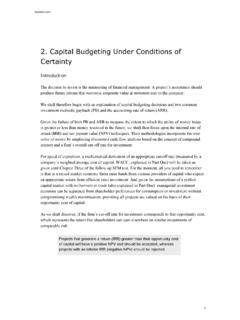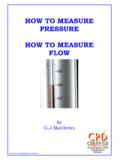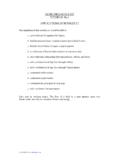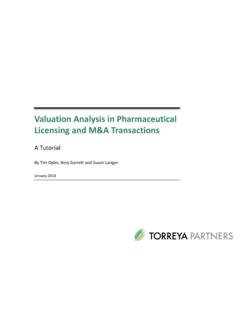Transcription of 5 Hydroelectric Power - WBUTHELP.COM
1 5 Hydroelectric PowerArchimedes was a mathematician and inventor from ancient Greece (born 280 BC). He invented a screw-shaped machine or hydraulic screw that raised water from a lower to a higher IntroductionHydraulic Turbines are used for converting the potential energy of water into useful Mechanical Power to drive machines as in Mills or pumps or electrical energy using electrical generators. Hydroelectric Power stations can be classified according to Power output into micro hydro, mini hydro, small hydro and large hydro systems. The definitions according to the International Energy Association are as folloMicro hydro - Hydroelectric station with installed capacity lower than 100 kW Mini hydro - Hydroelectric station in the range of 100kW to 1 MW Small hydro - Hydroelectric station in the range of 1 MW to 30 MW Large hydro - Hydroelectric station with installed capacity of over 30 MWHydropower is a clean and renewable source of energy that can contribute to fighting climate change.
2 The following advantages make hydropower a much preferred option to any fossil fuel Power scheme: No fuel needed - The chief advantage of hydro systems is elimination of the cost of fuel. Hydroelectric plants are immune to price increases for fossil fuels such as oil, natural gas or coal, and do not require imported fuel. Longevity - Hydroelectric plants tend to have longer lives than fuel-fired generation, with some plants now in service having been built 50 to 100 years ago. Pollution free - Hydroelectric plants generally have small to negligible emissions of carbon dioxide and methane due to reservoir emissions, and emit no sulphur dioxide, nitrogen oxides, dust, or other pollutants associated with combustion.
3 Quick Response - Since the generating units can be started and stopped quickly, they can follow system loads efficiently, and may be able to reshape water flows to more closely match daily and seasonal system energy demands. Environmentally friendly - Reservoirs created by Hydroelectric schemes often provide excellent leisure facilities for water sports, and become tourist attractions in Wildlife preserves can be created around reservoirs, which can provide stable habitats for endangered and threatened species(Eg. catch rates for game fish like walleye and small mouth bass are substantially higher on hydro Power reservoirs than natural lakes.)
4 Flood prevention the surplus water can be stored behind the dam and hence reduce the risk of Types of hydraulic turbinesDepending on the method of interaction between the fluid and the machine, there are two main types of turbines, IMPULSE and A Impulse TurbineThis type of turbine is usually selected for high head and low flow rate conditions. The water is usually directed on to the turbine blades via a nozzle and the jet will impinge and leaves the turbine at atmospheric high velocity jet leaves the nozzle at atmospheric pressure and impinges on to the wheel blades or tangential force exerted on the buckets is produced by a change in momentum of the jet, both in magnitude and most important type of impulse turbine is the PELTON : Pelton Turbine (Wheel) Courtesy of.
5 #B Reaction TurbineThis type of turbine is usually selected for low head conditions, but relatively higher flow rate than in impulse turbines. In reaction turbines part of the pressure energy is transformed into kinetic energy in the stationary guide vanes and the remainder is transferred in the runner wheel. This type of turbine does not run at atmospheric; in fact the pressure changes continuously while flowing through the machine. The chief turbines of this type are the FRANCIS and KAPLAN : Francis Turbine Courtesy of: # Figure : Kaplan Turbine Courtesy of: # C Reversible Pump/TurbineModern pumped storage units require the use of a reversible pump / turbine that can be run in one direction as pump and in the other direction as turbine.
6 These are coupled to reversible electric motor/generator. The motor drives the pump during the storage portion of the cycle, while the generator produces electricity during discharge from the upper reservoir. Most reversible-pump turbines are of the Francis type. The complexity of the unit, however, increases significantly as compared to a turbine alone. In spite of the higher costs for both hydraulic and electrical controls and support equipment, the total installed cost will be less than for completely separate pump-motor and turbine-generator assemblies with dual water : Reversible Francis Turbine/Pump system Courtesy of.
7 Performance evaluation of Hydraulic TurbinesThe Power available from water can be expressed asP = Q g h x ( )Where P = Power available (W) = density (kg/m3) (~ 1000 kg/m3 for water)Q= water flow (m3/s)g = acceleration of gravity ( m/s2)h = falling height, head (m)The hydraulic efficiency depends on many factors such as the type of turbine and the operational conditions. Typical values are between 50% and 75%.The theoretical approach velocity of water is given ( )
8 However real hydropower stations have penstock of considerable length incorporating many pipe fittings, bends and valves, hence the effective head is reduced, and as such the real velocity of water approaching the turbine is less than that quoted in equation The volume flow rate of water is calculated by the continuity equation: Q = V x A ( )The different hydraulic turbines described in the previous section have different characteristics such as Power rating, operating head and rotational speed, the term specific speed is introduced to group the three terms.
9 K311V ( )The concept of specific speed helps to classify the different turbines according to the range in which they operate, see Table Figure Typical Power flow rate evaluation chart. Courtesy of: Of TurbineSpecific speed range K311V Francis70 500 Propeller600 900 Kaplan350 1000 Cross-flow20 90 Turgo20 80 Pelton, 1-jet10 35 Pelton, 2-jet 10 45 Table : Operating Range of Hydraulic Pumped storage hydroelectricity Some areas of the world have used geographic features to store large quantities of water in elevated reservoirs, using excess electricity at times of low demand to pump water up to the reservoirs, then letting the water fall through turbine generators to retrieve the energy when demand storage hydroelectricity was first used in Italy and Switzerland in the 1890 s.
10 By 1933 reversible pump-turbines with motor-generators were available. Adjustable speed machines are now being used to improve efficiency. Hydro-electric Power plants are economically viable because of the difference between peak and off-peak electricity prices. Pumped-storage plants can respond to load changes within electricity is the product of transforming the potential energy stored in water in an elevated reservoir into the kinetic energy of the running water, then mechanical energy in a rotating turbine, and finally electrical energy in an alternator or generator.



![Flow rate [m h] Total head [m] - Fristam](/cache/preview/5/1/6/a/6/5/c/e/thumb-516a65ce112381e6b5b16a683026e44a.jpg)




